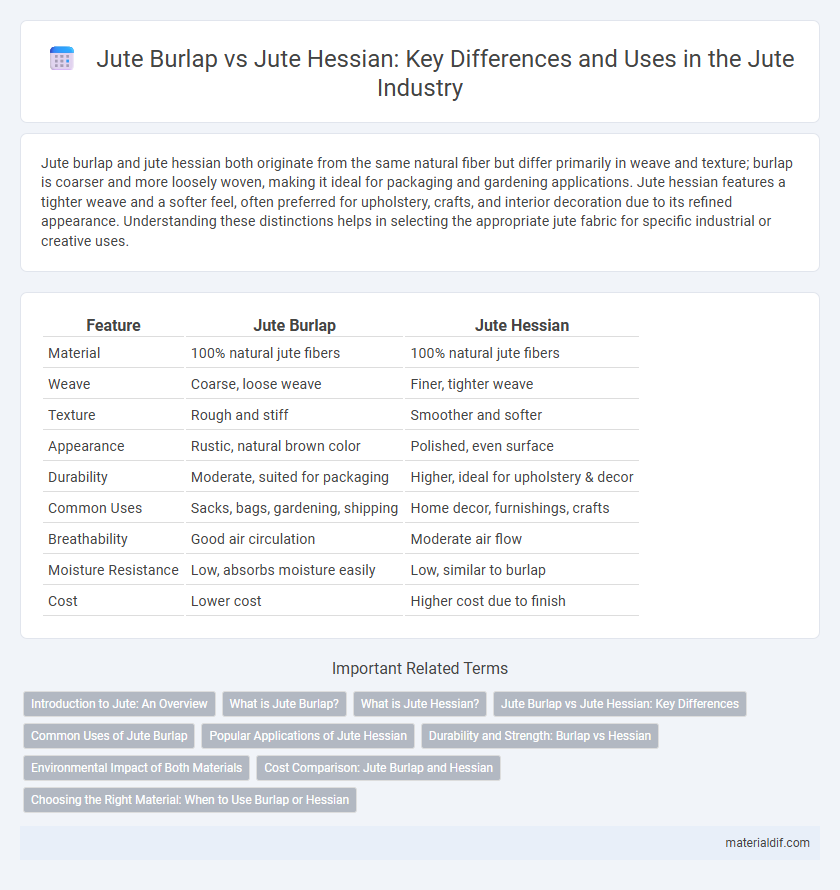Jute burlap and jute hessian both originate from the same natural fiber but differ primarily in weave and texture; burlap is coarser and more loosely woven, making it ideal for packaging and gardening applications. Jute hessian features a tighter weave and a softer feel, often preferred for upholstery, crafts, and interior decoration due to its refined appearance. Understanding these distinctions helps in selecting the appropriate jute fabric for specific industrial or creative uses.
Table of Comparison
| Feature | Jute Burlap | Jute Hessian |
|---|---|---|
| Material | 100% natural jute fibers | 100% natural jute fibers |
| Weave | Coarse, loose weave | Finer, tighter weave |
| Texture | Rough and stiff | Smoother and softer |
| Appearance | Rustic, natural brown color | Polished, even surface |
| Durability | Moderate, suited for packaging | Higher, ideal for upholstery & decor |
| Common Uses | Sacks, bags, gardening, shipping | Home decor, furnishings, crafts |
| Breathability | Good air circulation | Moderate air flow |
| Moisture Resistance | Low, absorbs moisture easily | Low, similar to burlap |
| Cost | Lower cost | Higher cost due to finish |
Introduction to Jute: An Overview
Jute burlap and jute hessian are natural fiber textiles derived from the jute plant, renowned for their eco-friendly and biodegradable properties. Jute burlap typically features a coarser weave used in packaging, gardening, and upholstery, while jute hessian offers a finer, more tightly woven fabric often utilized in home decor and crafts. Both materials share durability and breathability, making them valuable in sustainable applications across various industries.
What is Jute Burlap?
Jute burlap is a coarse, woven fabric made from natural jute fibers, commonly used for packaging, sacks, and upholstery due to its durability and breathability. Unlike jute hessian, which often refers to a finer, more uniform weave, burlap tends to have a rougher texture and is less refined. Its eco-friendly and biodegradable properties make jute burlap a sustainable choice in agriculture and craft industries.
What is Jute Hessian?
Jute Hessian is a coarse, woven fabric made from natural jute fibers, known for its durability and breathable properties. It is commonly used in sacks, upholstery, and eco-friendly packaging, distinguished by its tighter weave compared to jute burlap. Unlike jute burlap, which is rougher and more loosely woven, jute hessian offers a smoother texture and greater strength for industrial and agricultural applications.
Jute Burlap vs Jute Hessian: Key Differences
Jute burlap and jute hessian both originate from the jute plant but differ in weave and texture. Jute burlap typically features a looser, coarser weave ideal for rustic packaging and gardening applications, while jute hessian has a tighter, finer weave often used in upholstery and decorative textiles. These structural distinctions impact their durability, appearance, and suitability for specific industrial or craft purposes.
Common Uses of Jute Burlap
Jute burlap is commonly used in agriculture for soil erosion control, seed protection, and as a biodegradable weed barrier due to its breathable and durable nature. It also serves in packaging, particularly for coffee beans, potatoes, and other bulk goods, offering a sturdy and eco-friendly material. Additionally, jute burlap is popular in crafts and home decor, providing a rustic texture for upholstery, wall coverings, and event decorations.
Popular Applications of Jute Hessian
Jute Hessian is widely used in agriculture for crop protection, soil erosion prevention, and as biodegradable mulch mats due to its breathability and durability. It also serves in the upholstery and interior design industries for eco-friendly furniture backing and rustic home decor. The textile's coarse texture and robust weave make it popular for bags, sacks, and packaging materials.
Durability and Strength: Burlap vs Hessian
Jute burlap typically offers moderate durability and strength, making it suitable for lightweight applications like packaging and decoration. Jute hessian is woven more tightly and is stronger and more durable, favored for heavy-duty uses such as sacks, upholstery, and erosion control. The denser weave of hessian enhances tear resistance and longevity compared to the more loosely woven burlap.
Environmental Impact of Both Materials
Jute burlap and jute hessian both offer biodegradable and renewable options with minimal environmental footprint, as they are derived from the jute plant, which requires low water and pesticide use. Jute burlap tends to be coarser and less processed, often involving fewer chemical treatments, which can enhance its eco-friendliness compared to the more refined jute hessian fabric. Both materials contribute to sustainable practices by reducing plastic reliance and supporting carbon sequestration through jute cultivation.
Cost Comparison: Jute Burlap and Hessian
Jute burlap typically costs less than jute hessian due to its rougher weave and lower manufacturing complexity. Jute hessian, known for its finer texture and higher durability, commands a slightly higher price in both retail and bulk markets. Price variations also depend on factors like fabric weight, width, and finishing treatments, influencing the overall cost comparison between jute burlap and hessian.
Choosing the Right Material: When to Use Burlap or Hessian
Jute burlap is ideal for gardening and packaging due to its coarse texture and breathability, allowing moisture control and root aeration. Jute hessian, with its finer weave and smoother finish, is better suited for decorative purposes, upholstery, and eco-friendly crafts where appearance and durability matter. Selecting between burlap and hessian depends on the specific application requirements such as texture, strength, and aesthetic appeal.
Jute Burlap vs Jute Hessian Infographic

 materialdif.com
materialdif.com